|
Johnny Burris
Home
Vessels
Cargoes
Archives
Mariners
Bumboat
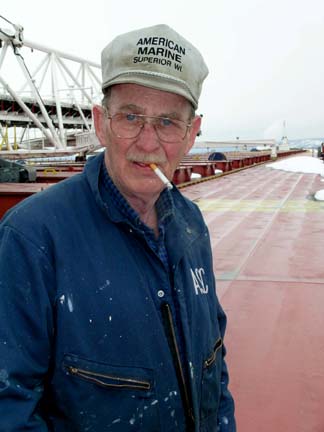
|
The H. Lee White arrived for winter lay-up at Duluth’s
Port Terminal on New Years Day, January 1, 2002, coming to a stop
alongside the East Warehouse building. Only a thin layer of ice coated
the harbor, not even enough to call out a tug to break a track. By
January, unless you’re clinically insane, everybody is in a
hurry to get home. Bags and boxes, TVs and stereos are already packed,
ready to shove into a car or taxi and get on the road. The deck crews,
usually the last to arrive in the spring, are the first to go home
in the winter. Before the engines are even completely shut down most
are on their way to the airport, or behind the wheel of a car without
a glance behind to the ship left at the dock. The engine crew is the
next to go after shutting down engines and machinery, emptying water
lines, and finishing up a long list of maintenance items for the shipyard
gangs. The galley crew is usually the last to leave, staying on to
cook for the engine crew, stripping the rooms of linens, getting the
spring grocery order ready for their return. Into the midst of this
maelstrom of activity steps the ship keeper, the person who will tend
this 700-foot box of steel for two and a half to three months.
* * *
It’s just before eight o’clock on a Friday night,
a month into winter lay-up. The last of the winter work crews have
slowly left the ship, heading back to motels or home for the weekend.
An Alberta Clipper has been running in all day off the Canadian
Plains, funneling wind gusts over forty miles per hour towards the
twin ports of Duluth-Superior. The winds, at sustained speeds of
20 to 30 miles per hour, cascade like a waterfall over the hill
at Duluth, increasing in speed as they head east across Lake Superior.
Big flakes of dry snow whip in circles, moving again and again before
finally landing. As the clipper moves in, temperatures begin to
fall, and the warnings go up for dangerous wind chills.
On the H. Lee White, tied to its berth at the Duluth Port
Terminal, ship keeper Johnny Burris finally settles down on a chair
in the ship’s galley. He lights a cigarette and dials home
on his cell phone. Ship keeping is not new to Johnny. In 1970 Johnny
worked the “winter gang” for Cleveland-Cliffs aboard
the Champlain and in 1973 he took his first official ship
keeping job, living with his wife and their newborn daughter aboard
The International at the Sturgeon Bay shipyard. Since then
Johnny has kept ship nearly every winter, even after his official
retirement from his steward’s position.
The ship groans and creaks in the wind, the steel mooring lines
vibrating as the cold air whistles around them. The ship has been
restless all day and before Johnny barely has time to say hello
the ship is suddenly plunged into darkness. Johnny instinctively
heads for a drawer that contains an emergency flashlight. If the
shore power is disrupted, the emergency power generator should come
on line within a couple of minutes. Johnny can hear the relay click,
but the generator isn’t turning over. What’s worse is
that Johnny can no longer hear the vibration in the steel cables
that hold the White to the dock. The White is
not only black as night, it is eerily quiet. Johnny is a veteran
sailor, and as he heads for the outside deck he feels and senses
something unusual that makes him quicken his pace; the ship is moving.
Even a novice ship keeper would know this is not a good feeling.
Winter ships are not supposed to move.
“I don’t think I’ve got much of a story,”
says Johnny at the close of a conversation we had one wintry afternoon
in Duluth. Having spent the better part of thirty-four years working
aboard ships on the Great Lakes Johnny Burris is surprisingly humble.
It has taken me a long time to write this story. Just as there is
always a time to hear a story, there is also a time to tell a story.
As the first snow of the season lands around me, quietly covering
the past months of sun and warmth, it is time to think about the
life and work of a man that is so intertwined with summer sailing
and winter ships. Maybe I took it to heart when Johnny told me he
didn’t have much of a story to tell. I first met Johnny Burris
aboard the H. Lee White where he was winter ship keeping.
I can still recall Johnny, introducing himself and his wife Marcia
in the pilot house, looking like a latter day pirate with a small
dog perched upon his shoulder. “They call me ‘Tennessee.’”
Johnny’s story begins in Jellico, Tennessee, nestled in the
Appalachian Mountains along the border of Tennessee and Kentucky.
Jellico was founded as a mining town, its name taken from a seam
of high quality bituminous coal known as Jellico Coal. As the coal
ran out and little future remained in mining, Eastern Tennessee
and Kentucky became poverty stricken. “Destitute” is
the word Johnny uses to describe the Tennessee of his youth. When
the deep mines shut down in the late 1940s there was little choice
for Johnny’s family except to move on. Johnny’s father
and his oldest sister moved north to Cleveland to find work, sending
for the rest family shortly after.
Cleveland in the late 1940s was a bustling, hard working city; a
gritty place like Jellico, only much larger. At the end of World
War Two Cleveland was a center of heavy industry, a mainstay of
coal; iron ore; oil; shipping; and manufacturing. Steel mills lined
the upper reaches of the Cuyahoga River. Away from the river the
automotive industry provided thousands of jobs for men and women,
including the newly arrived Burris family.
Johnny left school at an early age in Tennessee and didn’t
have much interest in returning to school by the time he got to
Cleveland. When he turned 18 Johnny sought his place in the factories
of Cleveland, finding work at the Brook Park Foundry. A lack of
experience and seniority made it tough for him to hold a steady
job and lay-offs were frequent and disruptive. Johnny’s landlord,
a superintendent with the Great Lakes Dock & Dredge Company,
suggested he try sailing and offered to set him up with a friend
to get his Seaman’s card. With nothing to lose Johnny jumped
at the chance for a job as deckhand on the steamship Pontiac.
Johnny quickly discovered that he didn’t like being away from
Cleveland and soon returned to the automobile factories.
After three weeks in Cleveland an uncertain Johnny decided to go
back to the boats, this time shipping out on the Adam E. Cornelius,
for Boland & Cornelius of Buffalo, New York. Instead of working
on deck Johnny started out in the galley as a porter making $1.67
an hour. The work on the boats wasn’t ideal, but it was steady.
This time Johnny stayed on the Cornelius, returning to
Cleveland only during the off-season to pick up part-time work in
the factories.
|
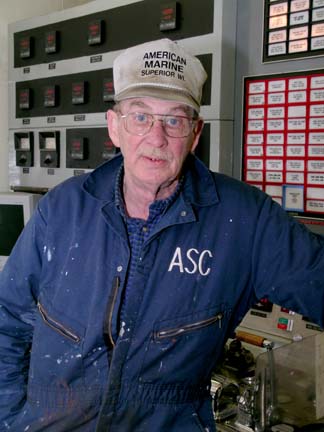
|
* * *
In 1968 Johnny shipped out as a porter aboard International Harvester’s
The International. Johnny, working as the night porter,
caught the attention of the Chief Steward on The International,
a fellow named Niles Stibbs, from Algoma, Wisconsin. Niles wanted
Johnny to learn the 2nd Cook’s job and offered to teach him
everything he’d need to know to be successful. “Niles,
I can’t even spell potato” pleaded Johnny. “I
don’t even know how to make the menu up. I’ve never
done this work before.” It was to no avail. Niles saw beyond
Johnny’s deficiencies and quipped “Yeah, I don’t
know how to say “tater” either!”
Johnny spent the next ten years working in the galley on The
International during the regular sailing season, then taking
relief jobs on other ships, working in the deck department or in
the engine rooms when The International went to lay-up.
“I wasn’t even going to stay on that ship,” recalled
Johnny. “When I went on there I was only going to stay, whatever
came first, the paycheck, or Cleveland. I wouldn’t have this
job today if it hadn’t been for the old steward on The
International.”
The steamer The International was built in 1923 at the
Lorain yard of the American Shipbuilding Company. The vessel was
launched as the William H. Warner, sailing for the next
decade under the flag of the G. A. Tomlinson fleet. In 1934, the
586-foot vessel was purchased by the International Harvester Company.
The normal trade route for The International was from South
Chicago to Escanaba or Marquette. The vessel carried a crew of 36
men when Johnny sailed aboard it, most coming from Chicago, or the
upper peninsula of Michigan. In later years The International
would make occasional trips to the Upper Republic Steel Mill in
Cleveland.
The Wisconsin Steel mill was located along the Calumet River, at
105th Street and Torrance Avenue in South Deering. The history of
the steel mill can be traced back to the 1875 era Joseph H. Brown
Iron and Steel Company. In a chronicle of Chicago’s East Side
industrial heritage Rod Seller writes, “In about 1900 the
mill was taken over by the Deering Harvester Company which merged
with the McCormick Company and formed International Harvester Company
and in 1905 the name of the mill was changed to Wisconsin Steel”
(Sellers 2003).
Niles began teaching Johnny the 2nd Cook’s job, and Johnny
for his part learned to cook. “He was the old fashioned cook,
and all the guys would beller at the way he made coffee. He wouldn’t
let anybody make coffee but him. Well, we could put the water on
the stove for him,” laughed Johnny. “He would boil the
water and then he would just take the coffee and dump it in there,
and then put eggshells on top of that.” Niles would let the
grounds soak down into the hot boiling water, before straining it
into an urn. “That was his way of making coffee,” Johnny
recalled. Ell Barclay, an assistant engineer on The International,
used to complain almost daily about the coffee. It didn’t
make any difference to Niles. “He didn’t change till
the day he left.” Over time Johnny learned to make breads
and pastries as well as to respect Nile’s culinary abilities.
“He wasn’t a fancy cook or anything like that. Everything
he made was very tasty. He was good. The guy was an excellent cook
in my view.”
In addition to learning to cook, Niles taught Johnny the fine art
of diplomacy when dealing with officers and crew members alike.
“A lot of times, the forward end and the after end would fight
amongst each other, or the captain didn’t like the chief,
or the chief didn’t like the captain.” Johnny and Niles
would often find themselves caught in the middle of someone else’s
bickering, with nothing to do but wait until it blew over. “If
I was friendly with the captain, the chief would be mad. If I was
friendly with the chief, the captain would be mad. You know what
I mean? Or, if you’ve got two friends aboard the boat and
they don’t like each other, well, if you’re talking
with one or the other you can cut it with a knife.” |
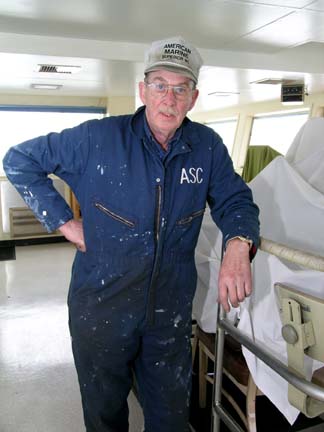
|
* * *
In the mid 1970s the AMO (American Maritime Officers) began to
organize the mates on The International, but not the galley
staff. By chance, when one of the mates decided to not vote to organize,
the union needed to find another vote. The AMO offered Chief Steward
Niles Stibbs a deal to work a set number of days in trade for full
benefits, and an early retirement. It was a sweet deal for Niles
so he put in his time and was able to retire. Johnny, as the ship’s
2nd Cook, and the ship’s Porter, remained in the SIU (Seafarers
International Union) as non-licensed union members. Johnny would
not be eligible to join the AMO until he attained a Chief Steward’s
job. When Niles Stibbs retired he was replaced with an out of work
AMO cook from one of the U. S. Steel ships while Johnny was forced
to remain as 2nd Cook.
The 1970s also saw new diesel-powered ships began replacing the
older steamers on the Great Lakes. These ships are arguably more
comfortable than the old steam ships. Heat is available year-round,
on demand, without having to build steam up, and in summer air conditioning
is available for all the rooms. The ships have cable TV, and many
are now equipped with satellite systems. The living quarters are
all located at the aft end so that the crew no longer has to make
a long walk from the forward end back aft to the galley, as in the
old days. In short, they’re very efficient; very convenient.
In Johnny’s estimation they are more comfortable, but they
have also changed the face of the men and women who work aboard
them. “You can go out on deck and there won’t be anybody
there. They’ve got satellite TV today; everybody’s got
their cell phones so they can be talking to their wife right in
their room. They don’t leave the rooms.”
“Years ago on those old boats everybody would be sitting out
on the hatches, like when you’re going through the Soo Locks.
Everybody’s out there bullshitting and having a good time.
And it’d last, you know, in the summertime till it got dark
for the people that weren’t working. It was a good time in
those days. You could sneak a beer out there and drink it in a cup
where it was undetected, as long as you weren’t holding a
bottle.”
Great Lakes sailors used to enjoy a reputation for being a heavy
drinking crowd. Today, changes in regulations and the responsibilities
that go with the enormous expense of operating a ship have drastically
curtailed the former carefree days of the sailor. Ports where the
docks were close to downtown were always favorites: Rogers City;
Escanaba; Conneaut; and Ashtabula. “Cleveland wasn’t
that great ’cause you’re down in the Flats and it was
three hours up the river you know. It wasn’t bad when they
had the grocery boat that would come out and pick you up.”
South Chicago was a favorite for the crew of The International
because the ship made port every week and it was easy to get around.
Johnny recalled some of the colorful names of the tavern proprietors
in South Chicago. “You had Peckerhead Kate’s. That was
up on Chicago Avenue. I think it was Chicago Avenue; and you had
Horseface Mary. She’d take you to the whore houses and wait
for you to bring you back to the bar. The guys would stay upstairs
there in the winter time. She’d kind of support the guys in
the winter months, and collect off of them in the sailing season.”
Superior and Toledo were also known as good ports for entertainment
for sailors when they were off the ship.
For many years the shipping companies didn’t offer unemployment
during the off-season, creating a flood of sailors looking for factory
work during the winter months. The International would
usually winter at the steel mill in South Deering, the home of International
Harvester’s Wisconsin Steel mill. In many instances the vessel
would shut down earlier than most of the other ships on the Great
Lakes, finishing its season when the mill at South Chicago had enough
taconite pellets to last for the winter. Rather than look for work
on shore Johnny would bounce around to other boats, such as the
Charles M. Beeghly, or the Irvin S. Olds, working
as a deckhand or in the engine department as a wiper.
When those ships finally stopped running Johnny returned to South
Chicago to work in the steel mills. The personnel manager at Wisconsin
Steel knew that sailors were usually hard working men trying to
support their families, and those working on the International Harvester
ship were given preference. “We’ve hired you guys in
here before, but the minute that whistle blows you guys leave us
and go back on the boats.” Johnny found the schedule disagreeable,
working split shifts, one week at night, one week in the day, and
on call twenty-four-seven. “He was right,” said Johnny.
“When the whistle blew, I went back sailing.”
|
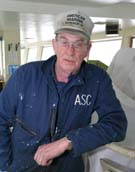
|
* * *
The late 1970s and early 1980s were transition years for Johnny.
The U. S. domestic steel industry was in recession, causing mills
to close and eventually forcing a number of the fleets working on
the Great Lakes to either drastically reduce the number of ships
they operated, or go out of business. Unfortunately in some cases
it was both.
International Harvester sold its lone remaining ship, The International,
in 1977. At the start of the 1978 sailing season Johnny began looking
for a new job when an opportunity for a Steward’s position
opened aboard the steamer Cliffs Victory. “It was
the only boat I was ever on where a cook an office, and a bedroom.”
It didn’t last long. “I was only on there twenty days.”
Johnny spent the remainder of that transitional season aboard the
Charles M. White, holding the Steward’s job on there,
hoping that he would get back to the Cliffs Victory. Johnny’s
hope for a permanent Stewards position with Cleveland-Cliffs vanished
in the spring of 1979 when Cliffs laid up most of its vessels, going
out of business the following year.
In 1979 the American Steamship Company became Johnny’s permanent
home when he signed aboard the Consumers Power as Chief
Steward. “May 15. I’ll never forget it. It was real
warm. The ship was in Toledo; and it was late getting out. That’s
the reason I remember it so well. That’s my seniority date
with the company too, May 15, 1979.” Johnny recalled with
ease his start with ASC that spring. At ASC Johnny finally gained
status in the AMO, but joining the officer’s union also meant
starting at the bottom of the seniority list. Johnny was unable
to land a permanent Steward’s position for several years as
the fleet rode out the steel recession. With a new ship, a new fleet
and new friendships to make, in many ways it was like starting over.
In 1982, after two seasons as a relief cook Johnny worked only thirty
days before the recession idled many of the boats. That summer,
instead of cooking, Johnny worked aboard the American Mariner as
a “ship keeper” until the vessel sailed late, in November.
The following season shipping on the lakes began to return to normal.
Johnny worked full time on the John J. Boland (2) and by
1985 found a more permanent home for many years as steward aboard
the Charles E. Wilson. At some point in his career with
ASC Johnny worked on nearly every vessel in the fleet, from the
old steamers like the Detroit Edison, the Nicollet,
and Joe Young, to the new river class of vessels, the Wilson,
the American Republic, Sam Laud, and St. Clair,
to the thousand-foot ore carriers Indiana Harbor and Belle
River.
* * *
|
|

|
For a Steward, the start of the shipping season is usually the most
hectic time of the year. “Fit- out” means coming aboard
before any of the crew has arrived. In addition to food preparation
the steward is responsible for running the “hotel services”
on the ship. Items that needed attention at the end of the last season,
such as mattresses and chairs, are replaced. Linens are distributed
to all the rooms on the ship. Food supplies for the galley are loaded
aboard, inventoried and stowed in the pantries, freezers and refrigerators.
The galley crew readies the engine department’s rooms first
because they are the first members of the ship’s crew to arrive.
Once the engine crew has arrived the vessel is full of extra people
such as inspectors from the Coast Guard and the ABS (American Bureau
of Shipping); shipyard workers finishing up projects; office personnel;
and medical personnel doing physicals. Once the deck crew arrives
the work in the galley is disrupted by additional preparations like
fire and lifeboat drills, taking more time out of an already hectic
day.
“What you’re doing as a Steward, you’re
fixing daily meals, like a restaurant. A restaurant has two choices
daily for special evening meal, they have a luncheon special, and
they have a supper or dinner special. This is what we’re doing
every day.” When Johnny started out the “traditional”
menu was more rigid, with certain nights of the week reserved for
a particular food. Saturday night was always Steak night, a “tradition”
which eventually changed to Wednesdays. “It was Saturday night’s
steak night, and Friday night’s fish night, and Sunday was always
some kind of chicken. Like for me, on Sundays for lunch I would have
burgers and fries, and chili hot dogs, and a chicken soup. Well, you
have a salad bar now,” conceded Johnny. “That just came
in the later years, a salad bar. For supper I’d have either
a baked chicken or a fried chicken, or turkey or something of that
nature.” Everyone who has ever been aboard a ship on the Great
Lakes for any length of time would agree that you’d have to
be a very picky to go hungry.
A long day is part of the routine for the galley staff on a ship.
The day typically begins around 6:30 in the morning when tables are
set for breakfast, menus are written for the day, and breads and rolls
are set to rise. For Johnny an average day was broken into three main
meals. “Breakfast was from 7:30 to 8:30; one hour. Then you
could knock off about 9 o’clock for an hour, 9:30 to 10:30.
I never did, but that was legal. The porter did ’cause he could
get away, but with my job I had stuff in the oven that I had to watch,
so I usually didn’t. Then we’d work from 10:30 to 1. Then
we’d knock off from 1 until 3:30, and then you come back and
work till 6 to get your day in.”
During an average breakfast on a lake boat in the early 1980s the
galley would go through about three dozen eggs, and four to five pounds
of bacon. “Some guys would order three and four times,”
recalled Johnny; before people became more concerned with health and
high cholesterol. The galley would go through an average of three
gallons of milk per day. Lunch is usually the smallest meal on the
ship. “If you’ve got a guy that works from 4 to 8 in the
morning there’s a damn good chance he isn’t going to be
up for lunch, so you won’t see those guys.” If a sailor
was in his home port he was more likely to be at home than on the
ship. Dinner is always the largest meal on the ship, with roughly
18 to 20 out of the crew dining. If the ship was at the dock Johnny
could always expect family and friends to be dining as well. “You
get more people off the street than you do the crew,” he laughed.
“It is the damn truth.” Certain vessels in the ASC fleet
even earned a reputation for frequently having guests at dinner. In
a sense, the number of dinner guests also reflected on the quality
of the food prepared by the Chief Steward.
Periodically, depending on the ship, guests of the company would take
short trips. These trips, a mix of pleasure and business, were most
often reserved for customers of the company. Guests aboard the ships
at the dock are a part of life, but guests aboard the ships mean different
things for the crew. When Johnny sailed many of the crew didn’t
care for the passengers that would ride for a week during the summer
months, and for the most part they were able to avoid much contact
with them. The galley staff, whether they liked passengers or not,
were in a position of having to interact with them on a daily basis.
Johnny could never understand the fascination these passengers had
with the boats. “They kind of come on a boat expecting all this
glamorous stuff and it’s just not there. These ships are made
to haul cargoes. You know what I mean?” Although Johnny would
admit to be “uncomfortable” with passengers, it was part
of his job and in looking back he manages to have some good laughs
over some of the escapades that went on aboard the ships.
One such trip earned Johnny a certain amount of notoriety within the
fleet for his culinary skills, and diplomatic finesse. Ned Smith,
the president of the American Steamship Company, while taking a trip
aboard the H. Lee White ordered chicken noodle soup for lunch
one day. Johnny remembers the 2nd Cook coming back all flustered when
the president sent him back to the galley for more soup. “He
says, ‘I’d like to have another order of that. It’s
real good, but there isn’t enough chicken in it. Make sure there’s
some chicken in it this time.’” Johnny always liked Mr.
Smith and knew him to be a pretty good joker, so he personally went
out to the dining room to discuss the situation. “Well,”
Johnny told Mr. Smith, “purchasing wants me to cut down on the
chicken and give you more noodles. It’s cheaper” he joked.
“I’m just trying to protect your company.” Both
men had a good laugh and Johnny returned to work in the galley as
Mr. Smith finished his lunch. Johnny thought he had gotten off pretty
easy this time, until a package arrived in the mail couple weeks later.
Johnny was clearly puzzled as he looked at the package. “It’s
all wrapped up, and it’s from the president of the company,”
he explained. “I opened it up and there’s a rubber chicken
in there.” By this time the story had gone around to all the
ships in the fleet, as well as the home office personnel. Several
weeks later the fleet safety director was aboard, and more than innocently
inquired about the rubber chicken. “He wanted to know if I still
had it,” said Johnny. “I said, ‘It’s up there
in the room.’ He asked, ‘Would you bring it down here
and pose for a picture for me?’” It was time to turn the
tables on Mr. Smith so to speak. The safety director wanted Johnny
to hold the rubber chicken over a pot on the stove so he could take
a picture to send back to the office. “That’s the story
behind that chicken,” laughs Johnny. The photograph of Johnny
and the chicken are still featured on the American Steamship web page
under the employment opportunities section for stewards.
|
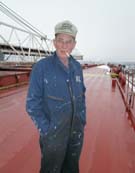
|
The winter of 2001-2002 was an unusually warm one, particularly
at the western end of Lake Superior. A winter ship keepers, for
his or her part, love the ice because it keeps their ship snug to
the dock. A winter like this one, with little or no ice, makes a
ship keeper a little nervous. There’s too much play in the
boat to ever let them feel comfortable. Without the firm layer of
ice to help hold the White to the dock that winter the
strong winds had finally gained momentum, pushing along the 700-foot
length of hull until it began to move away from the dock. While
Johnny sat in the galley the power line connected to the ship snapped
and the gangway ladder fell, slamming hard against the hull.
Johnny quickly reached the deck, opening the door to a blast of
cold air hitting him square in the face. Before he crossed the deck
Johnny could see what he already suspected, the ship was no longer
alongside the dock. The steel mooring line forward of the aft winch
had snapped. All that was holding the ship to the dock was the anchor
chain, now played out thirty feet from the dock. With no power to
control the mooring winches Johnny could only assess the situation
before reaching into his pocket for his cell phone to call for help.
In a matter of hours a crane and several workers had arrived to
put the ship back at the dock. It was some time after 2 a.m. before
Johnny was finally able to get some sleep.
In the summer of the year 2000 Johnny officially retired from his
job as steward, serving his final cooking days aboard the George
A. Stinson. He still keeps ship in the winter time but admits
it gets harder to leave his home in rural northwest Wisconsin when
the snow starts flying.
© 2003 Patrick Lapinski (all rights reserved)
|
|





